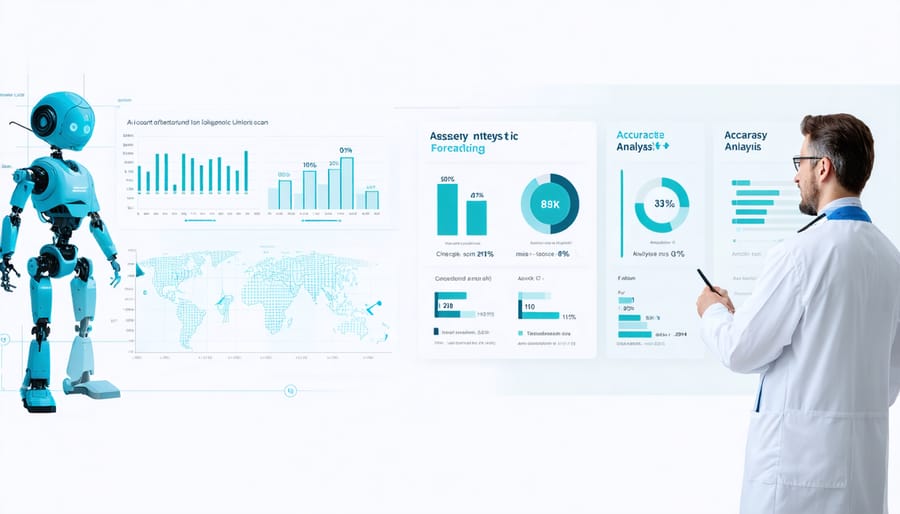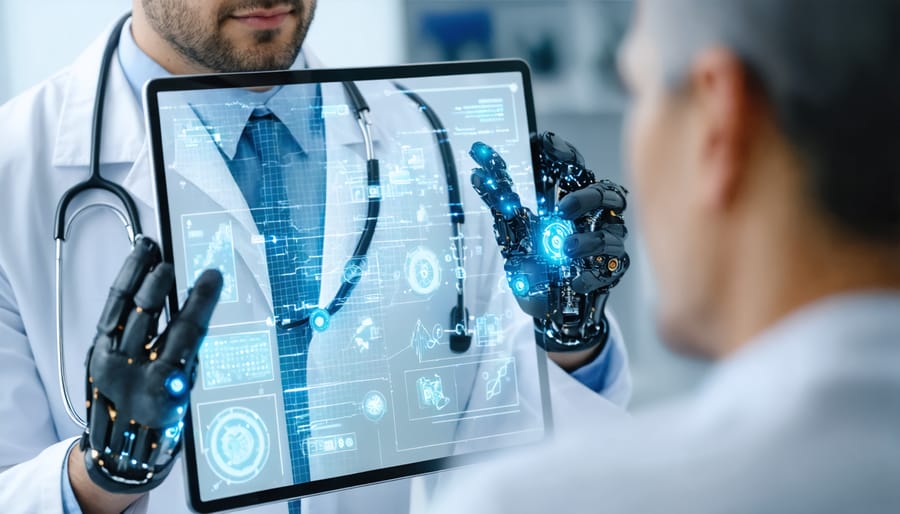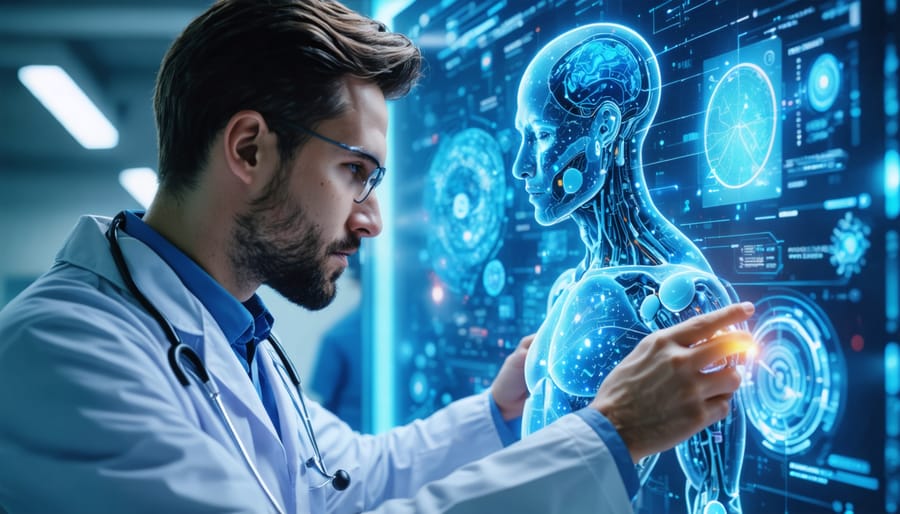Artificial intelligence is revolutionizing healthcare delivery, promising breakthrough advances in disease detection, treatment planning, and patient care optimization. As AI systems increasingly integrate into medical practices – from analyzing radiological images to predicting patient outcomes – healthcare professionals and patients alike grapple with crucial questions about its implementation, reliability, and impact on the doctor-patient relationship.
The stakes couldn’t be higher: AI’s potential to enhance diagnostic accuracy, reduce medical errors, and improve treatment efficiency must be balanced against concerns about data privacy, algorithmic bias, and the preservation of human medical judgment. Recent studies show that AI-powered diagnostic tools can match or exceed human expertise in specific areas, yet questions persist about their real-world reliability and integration into existing healthcare workflows.
From rural clinics to major medical centers, healthcare providers are seeking answers about AI’s role in their practice: How do we ensure AI recommendations remain transparent and explainable? What safeguards protect patient privacy? How can we maintain the human element of healthcare while leveraging AI’s analytical power? These questions shape the ongoing dialogue between technology innovators, medical professionals, and patients as we navigate the transformation of healthcare in the digital age.
Safety and Accuracy of AI Diagnostics
How Accurate Are AI Diagnostic Tools?
Modern AI diagnostic tools have shown remarkable accuracy in detecting various medical conditions, often matching or exceeding human performance in specific areas. Studies have demonstrated that AI algorithms can identify breast cancer in mammograms with 95% accuracy, compared to 86% for average radiologists.
However, it’s important to understand that AI accuracy varies significantly depending on the specific condition and the quality of training data. For example, AI systems have achieved over 90% accuracy in identifying skin cancer from images, but their performance may drop when faced with rare conditions or unusual presentations not well-represented in their training data.
Recent research from Stanford University showed that AI systems particularly excel at pattern recognition tasks, such as analyzing X-rays, MRIs, and pathology slides. In these areas, AI can process vast amounts of data quickly and spot subtle abnormalities that human eyes might miss. However, they still work best when partnered with human doctors who can provide context and consider patient-specific factors.
The key to understanding AI diagnostic accuracy lies in viewing these tools as supportive rather than replacement technologies. While they can enhance detection rates and speed up diagnoses, they’re most effective when integrated into existing medical workflows, combining machine precision with human expertise and judgment.

Can AI Make Critical Medical Decisions?
While AI’s role in medical decision-making continues to expand, the question of whether AI should make critical medical decisions independently remains contentious. Current best practices advocate for AI systems to serve as decision support tools rather than autonomous decision-makers.
AI excels at analyzing vast amounts of medical data, identifying patterns, and making evidence-based recommendations. However, healthcare decisions often require understanding complex human factors, emotional considerations, and ethical implications that AI systems aren’t yet equipped to fully comprehend.
Medical professionals typically use AI as a “second opinion” or verification tool, combining machine intelligence with human expertise. For instance, while AI might flag potential diagnoses in medical imaging with high accuracy, the final interpretation and treatment decisions remain with qualified healthcare providers.
The FDA and other regulatory bodies require human oversight for AI-powered medical devices and diagnostic tools. This “human-in-the-loop” approach ensures that critical decisions benefit from both AI’s computational power and human judgment.
Looking ahead, as AI technology evolves, its role may expand, but it’s unlikely to completely replace human decision-making in critical medical situations. Instead, the future points toward a collaborative model where AI enhances and supports human medical expertise rather than replacing it.
Data Privacy and Security

How Is Patient Data Protected?
Patient data protection in healthcare AI systems relies on multiple layers of security and strict compliance with regulations like HIPAA and GDPR. Healthcare organizations implement advanced encryption protocols to secure electronic health records and protect sensitive information during both storage and transmission.
Access control systems ensure that only authorized healthcare professionals can view specific patient data, with every access attempt being logged and monitored. Multi-factor authentication adds an extra security layer, requiring healthcare workers to verify their identity through multiple methods before accessing patient information.
AI systems themselves are designed with privacy-preserving techniques, such as federated learning, which allows AI models to learn from patient data without directly accessing or storing personal information. Data anonymization and pseudonymization techniques further protect patient privacy by removing or encoding identifying information before it’s used for AI analysis.
Regular security audits and penetration testing help identify and address potential vulnerabilities before they can be exploited. Healthcare organizations also maintain detailed incident response plans to address any potential data breaches quickly and effectively.
Healthcare staff undergo mandatory security awareness training to understand their role in protecting patient data and maintaining compliance with privacy regulations. This comprehensive approach ensures that AI integration in healthcare maintains the highest standards of patient privacy and data security.
Who Has Access to AI-Processed Medical Data?
Access to AI-processed medical data is governed by strict regulations and protocols designed to protect patient privacy while enabling healthcare advancement. Healthcare providers, including doctors and authorized medical staff, have primary access to AI-processed patient data through secure electronic health record (EHR) systems. These systems implement role-based access controls, ensuring that staff members can only view information necessary for their specific duties.
Research institutions and AI developers may access anonymized datasets for improving algorithms and developing new healthcare solutions. This data undergoes a thorough de-identification process, removing personal identifiers like names, addresses, and unique patient numbers before being shared.
Patients maintain significant rights over their medical data, including AI-processed information. Under regulations like HIPAA in the United States and GDPR in Europe, patients can request access to their complete medical records, including AI analysis results. They also have the right to know how their data is being used and can opt out of certain data-sharing programs.
Third-party access is strictly limited and typically requires explicit patient consent. Insurance companies may access specific AI-processed data for claim processing, while government health agencies might receive aggregated, anonymous data for public health monitoring and policy development.
Healthcare organizations must maintain detailed access logs and regularly audit who views AI-processed medical data, ensuring transparency and accountability in data handling practices.
Integration with Current Healthcare Systems
Will AI Replace Human Doctors?
While concerns about AI replacing human doctors are common, the reality is more nuanced. AI is emerging as a powerful tool to augment and enhance medical practice rather than replace healthcare professionals. Think of AI as a highly sophisticated assistant that can process vast amounts of medical data, identify patterns, and suggest potential diagnoses – but it can’t replace the human elements that are crucial to healthcare.
Medical professionals bring irreplaceable qualities to patient care: empathy, intuitive understanding, complex decision-making, and the ability to consider a patient’s unique circumstances and preferences. AI excels at analyzing medical images, predicting disease progression, and identifying drug interactions, but it lacks the ability to provide emotional support or make nuanced ethical decisions.
The future of healthcare likely lies in a collaborative approach where AI handles routine tasks, data analysis, and pattern recognition, while doctors focus on patient relationships, complex cases, and treatment decisions. This partnership can lead to more accurate diagnoses, reduced medical errors, and improved patient outcomes.
Many healthcare institutions are already implementing this complementary model, where AI tools support clinical decision-making while leaving final judgments to human professionals. This approach combines the computational power of AI with the irreplaceable human qualities of medical practitioners, creating a more efficient and effective healthcare system.

How Do Healthcare Providers Adopt AI?
Healthcare providers typically follow a structured approach when adopting AI technology in their practices. The process usually begins with a thorough assessment of their specific needs and identifying areas where AI can provide the most value, such as medical imaging analysis or patient data management.
The first step often involves forming a dedicated implementation team that includes both medical professionals and IT specialists. This team evaluates different AI solutions, considering factors like accuracy rates, ease of integration with existing systems, and cost-effectiveness. They also assess the technical infrastructure requirements and ensure compliance with healthcare regulations.
Training is a crucial phase of AI adoption. Medical staff need comprehensive education on using the new tools effectively, understanding their limitations, and interpreting AI-generated results. This usually involves hands-on training sessions, simulation exercises, and ongoing support from AI vendors.
Healthcare providers also need to establish clear protocols for AI use, including when to rely on AI insights and when human judgment should take precedence. They must implement monitoring systems to track the AI’s performance and make necessary adjustments.
The adoption process typically follows a gradual rollout strategy, starting with pilot programs in specific departments before expanding to wider implementation. This approach allows providers to identify and address potential issues early while building confidence in the technology among staff and patients.
Cost and Accessibility
Does AI Make Healthcare More Affordable?
The impact of AI on healthcare cost implications is complex and multifaceted. While the initial investment in AI technology can be substantial for healthcare providers, the long-term benefits often lead to significant cost savings. These savings primarily come from improved efficiency in diagnosis, reduced medical errors, and streamlined administrative processes.
For patients, AI-powered healthcare can translate into more affordable care through several mechanisms. Early disease detection and prevention, powered by AI algorithms, helps avoid costly treatments for advanced conditions. Additionally, AI-assisted remote monitoring and telehealth services reduce the need for frequent in-person visits, cutting down on transportation and time-off costs.
However, it’s important to note that cost benefits aren’t immediate or universal. Healthcare facilities must balance the investment in AI technology against potential savings. Some facilities pass these initial costs to patients, leading to temporary price increases. Yet, as AI technology becomes more widespread and standardized, costs typically decrease.
Studies show that AI implementation can reduce healthcare operational costs by 15-25% through automated tasks and improved resource allocation. This efficiency often translates to lower patient bills, particularly in diagnostic testing and routine care. Insurance companies are also beginning to recognize AI-assisted procedures, potentially leading to better coverage and reduced out-of-pocket expenses for patients.
Where Is AI Diagnostics Available?
AI diagnostic tools are becoming increasingly available across various healthcare settings, from major metropolitan hospitals to smaller regional clinics. Currently, leading medical centers in the United States, Europe, and Asia are at the forefront of implementing AI diagnostics, particularly in radiology, pathology, and medical imaging departments.
Many large hospital networks have begun integrating AI diagnostic systems into their standard procedures, especially for analyzing X-rays, MRIs, and CT scans. Countries like the United Kingdom, China, and Singapore have launched nationwide initiatives to incorporate AI diagnostics into their public healthcare systems, making these tools more accessible to the general population.
However, availability varies significantly by region and healthcare facility type. Rural areas and developing nations often face challenges in accessing these advanced technologies due to infrastructure limitations and cost barriers. Some healthcare providers are addressing this through telemedicine platforms that connect remote facilities to AI diagnostic capabilities in larger centers.
Looking ahead, major healthcare technology companies are working to expand access through cloud-based solutions and mobile applications. These innovations could make AI diagnostics more widely available, even in resource-limited settings. Additionally, several governments and healthcare organizations have announced plans to increase investment in AI diagnostic infrastructure over the next five years, suggesting broader accessibility in the near future.
For patients interested in accessing AI diagnostic tools, the best approach is to consult with their healthcare provider about available options in their area.
As we’ve explored throughout this article, AI in healthcare diagnostics represents a transformative force that’s reshaping the medical landscape. The integration of artificial intelligence has already demonstrated remarkable potential in improving diagnostic accuracy, reducing healthcare costs, and enhancing patient outcomes. From early disease detection to personalized treatment plans, AI tools are becoming invaluable allies to healthcare professionals.
Looking ahead, we can expect continued advancement in AI diagnostic capabilities, particularly in areas such as medical imaging, pathology, and predictive analytics. The development of more sophisticated algorithms, combined with increasing access to high-quality medical data, will likely lead to even more precise and reliable diagnostic tools.
However, success in this field requires careful attention to the challenges we’ve discussed. Healthcare providers must prioritize data privacy and security, ensure proper integration with existing systems, and maintain human oversight in decision-making processes. Additionally, addressing concerns about accessibility and cost will be crucial for widespread adoption.
The future of AI in healthcare diagnostics appears promising, with potential developments in real-time monitoring, automated screening, and personalized medicine. As technology continues to evolve, collaboration between healthcare professionals, technologists, and policymakers will be essential to harness AI’s full potential while maintaining ethical standards and patient trust.
The key to successful implementation lies in striking the right balance between technological innovation and human expertise, ensuring that AI remains a powerful tool that enhances, rather than replaces, the crucial role of healthcare professionals.

